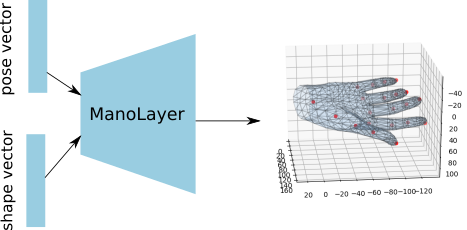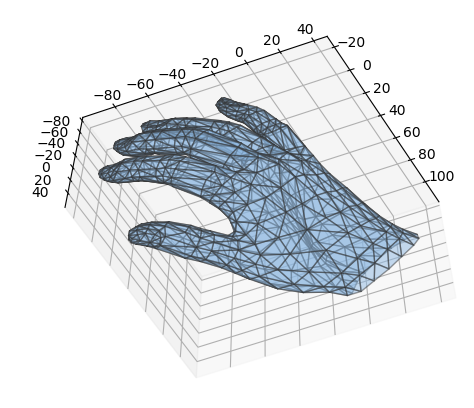Manopth
MANO layer for PyTorch (tested with v0.4 and v1.x)
ManoLayer is a differentiable PyTorch layer that deterministically maps from pose and shape parameters to hand joints and vertices. It can be integrated into any architecture as a differentiable layer to predict hand meshes.
ManoLayer takes batched hand pose and shape vectors and outputs corresponding hand joints and vertices.
The code is mostly a PyTorch port of the original MANO model from chumpy to PyTorch. It therefore builds directly upon the work of Javier Romero, Dimitrios Tzionas and Michael J. Black.
This layer was developped and used for the paper Learning joint reconstruction of hands and manipulated objects for CVPR19. See project page and demo+training code.
It reuses part of the great code from the Pytorch layer for the SMPL body model by Zhang Xiong (MandyMo) to compute the rotation utilities !
It also includes in mano/webuser partial content of files from the original MANO code (posemapper.py, serialization.py, lbs.py, verts.py, smpl_handpca_wrapper_HAND_only.py).
If you find this code useful for your research, consider citing:
- the original MANO publication:
@article{MANO:SIGGRAPHASIA:2017,
title = {Embodied Hands: Modeling and Capturing Hands and Bodies Together},
author = {Romero, Javier and Tzionas, Dimitrios and Black, Michael J.},
journal = {ACM Transactions on Graphics, (Proc. SIGGRAPH Asia)},
publisher = {ACM},
month = nov,
year = {2017},
url = {http://doi.acm.org/10.1145/3130800.3130883},
month_numeric = {11}
}
- the publication this PyTorch port was developped for:
@INPROCEEDINGS{hasson19_obman,
title = {Learning joint reconstruction of hands and manipulated objects},
author = {Hasson, Yana and Varol, G{\"u}l and Tzionas, Dimitris and Kalevatykh, Igor and Black, Michael J. and Laptev, Ivan and Schmid, Cordelia},
booktitle = {CVPR},
year = {2019}
}
The training code associated with this paper, compatible with manopth can be found here. The release includes a model trained on a variety of hand datasets.
Installation
Get code and dependencies
git clone https://github.com/hassony2/manopthcd manopth- Install the dependencies listed in environment.yml
- In an existing conda environment,
conda env update -f environment.yml - In a new environment,
conda env create -f environment.yml, will create a conda environment namedmanopth
- In an existing conda environment,
Download MANO pickle data-structures
- Go to MANO website
- Create an account by clicking Sign Up and provide your information
- Download Models and Code (the downloaded file should have the format
mano_v*_*.zip). Note that all code and data from this download falls under the MANO license. - unzip and copy the
modelsfolder into themanopth/manofolder - Your folder structure should look like this:
manopth/
mano/
models/
MANO_LEFT.pkl
MANO_RIGHT.pkl
...
manopth/
__init__.py
...
To check that everything is going well, run python examples/manopth_mindemo.py, which should generate from a random hand using the MANO layer !
Install manopth package
To be able to import and use ManoLayer in another project, go to your manopth folder and run pip install .
cd /path/to/other/project
You can now use from manopth import ManoLayer in this other project!
Usage
Minimal usage script
See examples/manopth_mindemo.py
Simple forward pass with random pose and shape parameters through MANO layer
import torch
from manopth.manolayer import ManoLayer
from manopth import demo
batch_size = 10
# Select number of principal components for pose space
ncomps = 6
# Initialize MANO layer
mano_layer = ManoLayer(mano_root='mano/models', use_pca=True, ncomps=ncomps)
# Generate random shape parameters
random_shape = torch.rand(batch_size, 10)
# Generate random pose parameters, including 3 values for global axis-angle rotation
random_pose = torch.rand(batch_size, ncomps + 3)
# Forward pass through MANO layer
hand_verts, hand_joints = mano_layer(random_pose, random_shape)
demo.display_hand({'verts': hand_verts, 'joints': hand_joints}, mano_faces=mano_layer.th_faces)Result :
Demo
With more options, forward and backward pass, and a loop for quick profiling, look at examples/manopth_demo.py.
You can run it locally with:
python examples/manopth_demo.py

